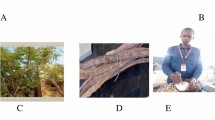Abstract
An attempt has been made to evaluate the use of natural, agro-based material, Moringa oleifera as a coagulant in the treatment of recreated water-based paint effluent. The treatment train sequence comprising coagulation, flocculation, sedimentation, sand filtration, and membrane filtration was used. The efficiency was evaluated in terms of color and turbidity. The influence of experimental parameters such as eluent type, eluent concentration, coagulant dose, coagulant-eluate volume, initial effluent pH, and initial effluent concentration was examined. The recommended conditions to yield maximum removal efficiency are 80 mL of eluate prepared using 3 g of M. oleifera seed powder and 1 N NaCl, under actual pH, to treat a liter of effluent. The treated supernatant from coagulation unit was passed through a sand filtration setup and a membrane filtration, with a maximum removal of color above 95%. The results affirmed the positive coagulation properties of M. oleifera, which could serve as a better alternative for chemical coagulant. The optimized treatment conditions derived for the recreated paint effluent were applied in the real paint effluent treatment. An opportunity was identified for re-using treated wastewater, as a cooling fluid and a diluting agent for lower quality paints.
The results affirmed the positive coagulation properties of M. oleifera, which could serve as a better alternative for chemical coagulant.

ᅟ










Similar content being viewed by others
References
Aboulhassan, M. A., Souabi, S., Yaacoubi, A., & Baudu, M. (2006). Improvement of paint effluents coagulation using natural and synthetic coagulant aids. Journal of Hazardous Materials, 138, 40–45.
Akyol, A. (2012). Treatment of paint manufacturing wastewater by electrocoagulation. Desalination, 285, 91–99.
APHA. (1995). Standard methods for the examination of waste and wastewater (Sixteenth ed.). New York: American Public Health Associations.
Arquiaga, M. C., Canter, L. W., & Robertson, J. M. (1995). Microbiological characterization of the biological treatment of aircraft paint stripping wastewater. Environmental Pollution, 89(2), 189–195.
Brown, J. A., & Weintraub, M. (1982). Bio oxidation of paint process wastewater. Journal of Water Pollution Control and Federation, 54(7), 1127–1130.
Chun, Y. Y. (2010). Emerging usage of plant based coagulants for water and wastewater treatment. Process Biochemistry, 45(9), 1437–1444.
Deya, B. K., Hashim, M. A., Hasan, S., & Sengupta, B. (2004). Microfiltration of water-based paint effluents. Advanced Environmental Research, 8, 455–466.
Flaten, T. P. (2001). Aluminium as a risk factor in Alzheimer’s disease, with emphasis on drinking water. Brain Research Bulletin, 55, 187–196.
Haung, C. P., & Ghadirian, M. (1974). Physical–chemical treatment of paint industry wastewater. Journal of Water Pollution Control Federation, 46(10), 2340–2346.
Kannan, R., Lakshmi, S., Radha, P., Aparna, N., Vishali, S., & Richard Thilagaraj, W. (2016). Biosorption of heavy metals from actual electroplating wastewater using encapsulated Moringa oleifera beads in fixed bed column. Desalination and Water Treatment, 57(8), 3572–3587.
Korbahti, B. K., & Tanyolac, A. (2009). Electrochemical treatment of simulated industrial paint wastewater in a continuous tubular reactor. Chemical Engineering Journal, 148(2–3), 444–451.
Korbahti, B. K., Aktas, N., & Tanyolac, A. (2007). Optimization of electrochemical treatment of industrial paint wastewater with response surface methodology. Journal of Hazardous Material, 148(1–2), 83–90.
Kumar, R., & Barakat, M. A. (2013). Decolourization of hazardous brilliant green from aqueous solution using binary oxidized cactus fruit peel. Bioresource Technology, 226(15), 377–383.
Magesh kumar, M., & Karthikeyan, R. (2016). Modelling the kinetics of coagulation process for tannery industry effluent treatment using Moringa oleifera seeds protein. Desalination and Water Treatment, 57(32), 14954–14964.
Mansour, M., Sivakumar, S., & Prasad, M. N. V. (2012). Binding of cadmium to S potatorum seed proteins in an aqueous solution: adsorption kinetics and relevance to water purification. Colloids Surface B, 94, 73–79.
Mohsen, A. E. L. S., Hasanin, E. A., & Kamel, M. M. (2010). Appropriate technology for industrial wastewater treatment of paint industry. American–Eurasian Journal of Agricultural and Environment, 8(5), 597–601.
Pamukoglu, M. Y., & Kargi, F. (2006). Removal of copper (II) ions from aqueous medium by biosorption onto powdered waste sludge. Process Biochemistry, 41(5), 1047–1054.
Rizzo, L., Gennaro, A. D., Gallo, M., & Belgiorno, V. (2008). Coagulation/chlorination of surface water: a comparison between chitosan and metal salts. Separation Science and Technology, 62, 79–85.
Sengupta, B., Dey, B. K., Hashim, M. A., & Hasan, S. (2004). Micro filtration of water-based paint effluents. International Journal of Environmental Management, 8(3–4), 455–466.
Shanta, S., & Kaul, S. N. (2000). Performance of evaluation of a pure oxygen-based activated sludge system treatment a combined paint industry wastewater and domestic sewage. International Journal of Environmental Studies, 58(4), 445–457.
Verma, A. K., Dash, R., & Bhunia, P. (2012). A review on chemical coagulation/flocculation technologies for removal of colour from textile wastewaters. Journal of Environmental Management, 93(1), 154–168.
Vishali, S., & Karthikeyan, R. (2014). A comparative study of Strychnos potatorum and chemical coagulants in the treatment of paint and industrial effluents: an alternate solution. Separation Science and Technology, 49(16), 2510–2517.
Vishali, S., & Karthikeyan, R. (2015). Cactus opuntia (ficus-indica): an eco-friendly alternative coagulant in the treatment of paint effluent. Desalination and Water Treatment, 56(6), 1489–1497.
Vishali, S., Rashmi, P., & Karthikeyan, R. (2016). Evaluation of wasted biomaterial, crab shells (Portunus sanguinolentus), as a coagulant, in paint effluent treatment. Desalination and Water Treatment, 57(28), 13157–13165.
Xiang, J. M., & Hui, L. X. (2009). Treatment of water based printing ink wastewater by Fenton process combined with coagulation. Journal of Hazardous Material, 162, 386–390.
Author information
Authors and Affiliations
Corresponding author
Rights and permissions
About this article
Cite this article
Vishali, S., Roshini, S.K., Samyuktha, M.R. et al. Towards zero waste production in the paint industry wastewater using an agro-based material in the treatment train. Environ Monit Assess 190, 587 (2018). https://doi.org/10.1007/s10661-018-6904-z
Received:
Accepted:
Published:
DOI: https://doi.org/10.1007/s10661-018-6904-z




